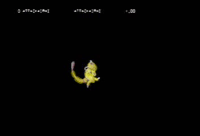No edit summary |
|||
| Line 12: | Line 12: | ||
== Disjointed Hitbox == |
== Disjointed Hitbox == |
||
| − | '''Disjointed hitbox''' describes an attacking red collision bubble that is not attached to the vulnerable yellow bubble. These are generally found on weapons, like swords or hammers. A disjointed hitbox, if attacked, cannot hurt the character. For example, If [[Marth]] attacks [[Ness]]'s [[PK Fire]] with his [[forward smash]], [[Marth]] will not be affected. However, if [[Mario]] punches the [[PK Fire]], he will sustain damage. Some disjointed hitboxes, such as [[Snake]]'s up tilt, are placed in very unexpected spots and, as such, can be used to surprise an opponent, not expecting a hitbox to extend so far. Famous disjointed hitbox's include Snake's Up tilt in |
+ | '''Disjointed hitbox''' describes an attacking red collision bubble that is not attached to the vulnerable yellow bubble. These are generally found on weapons, like swords or hammers. A disjointed hitbox, if attacked, cannot hurt the character. For example, If [[Marth]] attacks [[Ness]]'s [[PK Fire]] with his [[forward smash]], [[Marth]] will not be affected. However, if [[Mario]] punches the [[PK Fire]], he will sustain damage. Some disjointed hitboxes, such as [[Snake]]'s up tilt, are placed in very unexpected spots and, as such, can be used to surprise an opponent, not expecting a hitbox to extend so far. Famous disjointed hitbox's include Snake's Up tilt in Brawl and Kirby's up tilt in Smash 64. |
== Trapbox == |
== Trapbox == |
||
Revision as of 10:48, 27 March 2010

Example of Red, Orange, and Yellow Collision Bubbles, as demonstrated with Mewtwo's U-Air
A hitbox is the area of an attack that is able to damage your opponent. This area is invisible and is not always part of what is used to attack. Game developers use the term collision bubbles to describe hitboxes as well as the area of an object or character that the hitbox interacts with. Collision bubbles can only be viewed in Debug Mode. The status of each kind of collision bubble is represented by its color:
- Yellow represents a damagable area- The bodies of the characters and destructible stage areas.
- Orange represents a damagable hitbox- These can be found on projectiles with a lifespan that can be reduced by receiving attacks (Ness' PK Fire, Link or Young Link's bombs and arrows, Sheik's needles). Unknown if it's actually a separate hitbox type or simply a yellow and red hitbox of exactly the same size in the same place.
- Red represents a damaging hitbox- These can be found on most non-grab attacks.
- Purple represents a grab hitbox- These can be found on grabs as well as Ganondorf's Dark Dive, Captain Falcon's Falcon Dive, Kirby's Swallow, Yoshi's Egg Lay, and Bowser's Koopa Klaw. All these attacks share the characteristic of being able to penetrate the enemy's shield.
- Blue represents invincibility: an area of a character that is immune to attacks. This usually occurs as part of a dodge. Characters that attack something with blue collision bubbles will not suffer hitlag - essentially, blue collision bubbles do not exist for collision detection. (For example, when the blocks in Mushroom: Kingdom are broken, they turn from yellow to blue.)
- Green represents a temporarily non-damagable area- for instance, a character who has been off of the spawn platform for no more than two seconds, or for 8 frames at the start of a throw. Characters that attack something with green collision bubbles will suffer hitlag.
- Blue-green represents an area attached to a character that can interact with hitboxes in a specific way. It applies to shields (including Link and Young Link's hand shields), counters (Marth and Roy), reflectors, and absorbers (Ness and Mr. Game & Watch's down B).
Disjointed Hitbox
Disjointed hitbox describes an attacking red collision bubble that is not attached to the vulnerable yellow bubble. These are generally found on weapons, like swords or hammers. A disjointed hitbox, if attacked, cannot hurt the character. For example, If Marth attacks Ness's PK Fire with his forward smash, Marth will not be affected. However, if Mario punches the PK Fire, he will sustain damage. Some disjointed hitboxes, such as Snake's up tilt, are placed in very unexpected spots and, as such, can be used to surprise an opponent, not expecting a hitbox to extend so far. Famous disjointed hitbox's include Snake's Up tilt in Brawl and Kirby's up tilt in Smash 64.
Trapbox
The hitbox left on the ground during Ness' Yoyo Glitch. As with all hitboxes, trapboxes are invisible. It is called a trapbox because this hitbox is not attached at all to any kind of attack but instead just sits on the ground or, in some cases, floats in the air.
